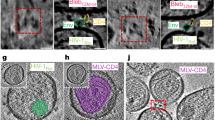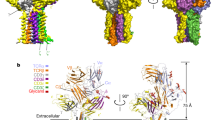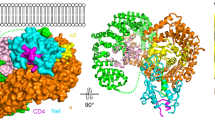Abstract
CD4, a member of the immunoglobulin superfamily of receptors that mediates cell-cell interactions in the immune system, is the primary receptor for HIV-1. The extracellular portion of CD4 is a concatenation of four immunoglobulin-like domains, D1 to D4. The D1, D2 and D4 domains each contain a disulfide bond. We show here that the D2 disulfide bond is redox-active. The redox state of the thiols (disulfide versus dithiol) appeared to be regulated by thioredoxin, which is secreted by CD4+ T cells. Locking the CD4 and the thioredoxin active-site dithiols in the reduced state with a hydrophilic trivalent arsenical blocked entry of HIV-1 into susceptible cells. These findings indicate that redox changes in CD4 D2 are important for HIV-1 entry and represent a new target for HIV-1 entry inhibitors.
This is a preview of subscription content, access via your institution
Access options
Subscribe to this journal
Receive 12 print issues and online access
$209.00 per year
only $17.42 per issue
Buy this article
- Purchase on Springer Link
- Instant access to full article PDF
Prices may be subject to local taxes which are calculated during checkout





Similar content being viewed by others
Change history
09 July 2002
Sentence, prime mark, and online figure were updated with note and PDF was appended with note. Issue PDF will contain "corrected 09 July 2002 (details online)"
References
Konig, R. Interactions between MHC molecules and co-receptors of the TCR. Curr. Opin. Immunol. 14, 75–83 (2002).
Sodroski, J.G. HIV-1 entry inhibitors in the side pocket. Cell 99, 243–246 (1999).
Maddon, P.J. et al. The isolation and nucleotide sequence of a cDNA encoding the T cell surface protein T4: a new member of the immunoglobulin gene family. Cell 42, 93–104 (1985).
Harris, R.J., Chamow, S.M., Gregory, T.J. & Spellman, M.W. Characterization of a soluble form of human CD4. Eur. J. Biochem. 188, 291–300 (1990).
Wang, J. et al. Atomic structure of a fragment of human CD4 containing two immunoglobulin-like domains. Nature 348, 411–418 (1990).
Ryu, S.R. et al. Crystal structure of an HIV-binding recombinant fragment of human CD4. Nature 348, 419–426 (1990).
Brady, R.L. et al. Crystal structure of domains 3 and 4 of rat CD4: relation to the NH2-terminal domains. Science 260, 979–983 (1993).
Katz, B.A. & Kossiakoff, A. The crystallographically determined structures of atypical strained disulfides engineered into subtilisin. J. Biol. Chem. 261, 15480–15485 (1986).
Weiner, S.J. et al. A new force field for molecular mechanical simulation of nucleic acids and proteins. J. Am. Chem. Soc. 106, 765–784 (1984).
Pace, C.N., Grimsley, G.R., Thomson, J.A. & Barnett, B.J. Conformational stability and activity of ribonuclease T1 with zero, one, and two intact disulfide bonds. J. Biol. Chem. 263, 11820–11825 (1988).
Ingalls, H.M., Goodloe-Holland, C.M. & Luna, E.J. Junctional plasma membrane domains isolated from aggregating Dictyostelium discoideum amebae. Proc. Natl. Acad. Sci. USA 83, 4779–4783 (1986).
Jiang, X.-M., Fitzgerald, M., Grant, C.M. & Hogg, P.J. Redox control of exofacial protein thiols/disulfides by protein disulfide isomerase. J. Biol. Chem. 274, 2416–2423 (1999).
Takebe, Y. et al. SRα promoter: an efficient and versatile mammalian cDNA expression system composed of the simian virus 40 early promoter and the R-U5 segment of human T-cell leukemia virus type 1 long terminal repeat. Mol. Cell. Biol. 8, 466–472 (1988).
Tonissen, K. et al. Site-directed mutagenesis of human thioredoxin. J. Biol. Chem. 268, 22485–22489 (1993).
Deen, K.C. et al. A soluble form of CD4 (T4) protein inhibits AIDS virus infection. Nature 331, 82–84 (1988).
Sowerby, D.B. in The Chemistry of Organic Arsenic, Antimony, and Bismuth Compounds (ed. Patai, S.) 25–88 (John Wiley and Sons, New York, NY, 1994).
Jauhiainen, M., Stevenson, K.J. & Dolphin, P.J. Human plasma lecithin-cholesterol acyltransferase. The vicinal nature of cysteine 31 and cysteine 184 in the catalytic site. J. Biol. Chem. 263, 6525–6533 (1988).
Donoghue, N., Yam, P.T.W., Jiang, X.-M. & Hogg, P.J. Presence of closely-spaced protein thiols on the surface of mammalian cells. Protein Sci. 9, 2436–2445 (2000).
Vandegraaff, N. et al. Specific inhibition of human immunodeficiency virus type 1 (HIV-1) integration in cell culture: putative inhibitors of HIV-1 integrase. Antimicrob. Agents Chemother. 45, 2510–2516 (2001).
Collman, R. et al. An infectious molecular clone of an unusual macrophage-tropic and highly cytopathic strain of human immunodeficiency virus type 1. J. Virol. 66, 7517–7521 (1992).
LaBranche, C.C. et al. Determinants of CD4 independence for a human immunodeficiency virus type 1 variant map outside regions required for coreceptor specificity. J. Virol. 73, 10310–10319 (1999).
Nakashima, I. et al. Redox mechanism as alternative to ligand binding for receptor activation delivering disregulated cellular signals. J. Immunol. 152, 1064–1071 (1994).
Lynch, G.W., Sloane, A.J., Rasco, V., Lai, A. & Cunningham, A.L. Direct evidence for native CD4 oligomers in lymphoid and monocytoid cells. Eur. J. Immunol. 29, 2590–2602 (1999).
Ryser, H.J.-P., Levy, E.M., Mandel, R. & DiSciullo, G.J. Inhibition of human immunodeficiency virus infection by agents that interfere with thiol-disulfide interchange upon virus-receptor interaction. Proc. Natl. Acad. Sci. USA 91, 45459–4563 (1994).
Richardson, J.A. Protein anatomy. Adv. Protein. Chem. 34, 167–339 (1981).
Karle, I.L., Kishore, R., Raghothama, S. & Balaram, P. Cyclic cystine peptides. Antiparallel β-sheet conformation for the 20-membered ring in Boc-Cys-Val-Aib-Ala-Leu-Cys-NHMe. J. Am. Chem. Soc. 110, 1958–1963 (1988).
Karle, I.L., Flippen-Anderson, J.L., Kishore, R. & Balaram, P. Cystine peptides. Int. J. Peptide Protein Res. 34, 37–41 (1989).
Williams, A.F., Davis, S.J., He, Q. & Barclay, A.N. Structural diversity in domains of the immunoglobulin superfamily. Cold Spring Harbor Symp. Quant. Biol. 65, 637–647 (1989).
Kirszbaum, L., Sharpe, J.A., Goss, N., Lahnstein, J. & Walker, I.D. The α-chain of murine CD8 lacks an invariant Ig-like disulfide bond but contains a unique intrachain loop instead. J. Immunol. 142, 3931–3936 (1989).
Holmgren, A. Thioredoxin. Annu. Rev. Biochem. 54, 237–271 (1985).
Tagaya, Y. et al. ATL-derived factor (ADF), an IL-2 receptor/Tac inducer homologous to thioredoxin: possible involvement of a dithiol-reduction in the IL-2 receptor induction. EMBO J. 8, 757–764 (1989).
Martin, H. & Dean M. Identification of a thioredoxin-related protein associated with plasma membranes. Biochem. Biophys. Res. Commun. 175, 123–128 (1991).
Rubartelli, A., Bajetto, A., Allavena, G., Wollman, E. & Sitia, R. Secretion of thioredoxin by normal and neoplastic cells through a leaderless secretory pathway. J. Biol. Chem. 267, 24161–24164 (1992).
Woolman, E.E., Kahan, A. & Fradelizi, D. Detection of membrane associated thioredoxin on human cell lines. Biochem. Biophys. Res. Commun. 230, 602–606 (1997).
Soderberg, A., Sahaf, B. & Rosen, A. Thioredoxin reductase, a redox-active selenoprotein, is secreted by normal and neoplastic cells: presence in human plasma. Cancer Res. 60, 2281–2289 (2000).
Bachelder, R.E., Bilancieri, J., Lin, W. & Letvin, N.L. A human recombinant Fab identifies a human immunodeficiency virus type 1-induced conformational change in cell surface-expressed CD4. J. Virol. 69, 5734–5742 (1995).
Sanejouand, Y.H. Normal-mode analysis suggests important flexibility between the two N-terminal domains of CD4 and supports the hypothesis of a conformational change in CD4 upon HIV binding. Protein Eng. 9, 671–677 (1996).
Burkly, L.C. et al. Inhibition of HIV infection by a novel CD4 domain 2-specific monoclonal antibody. J. Immunol. 149, 1779–1787 (1992).
Moore, J.P., Sattentau, Q.J., Klasse, P.J. & Burkly, L.C. A monoclonal antibody to CD4 domain 2 blocks soluble CD4-induced conformational changes in the envelope glycoproteins of the human immunodeficiency virus type 1 (HIV-1) and HIV-1 infection of CD4+ cells. J. Virol. 66, 4784–4793 (1992).
Nakamura, H. et al. Elevation of plasma thioredoxin levels in HIV-infected individuals. Int. Immunol. 8, 603–611 (1996).
Nakamura, H. et al. Chronic elevation of plasma thioredoxin: Inhibition of chemotaxis and curtailment of life expectancy in AIDS. Proc. Natl. Acad. Sci. USA 98, 2688–2693 (2001).
Roederer, M., Ela, S.W., Staal, F.J.T. & Herzenberg, L.A. N-acetylcysteine: A new approach to anti-HIV therapy. AIDS Res. Hum. Retroviruses 8, 209–216 (1992).
Dröge, W., Eck, H.-P. & Mihm, S. HIV-induced cysteine deficiency and T-cell dysfunction - a rationale for treatment with N-acetylcysteine. Immunol. Today 13, 211–214 (1992).
Bergamini, A. et al. Cystamine potently suppresses in vitro HIV replication in acutely and chronically infected human cells. J. Clin. Invest. 93, 2251–2257 (1994).
Ho, W.-Z. et al. Cystamine inhibits HIV type 1 replication in cells of monocyte/macrophage and T cell lineages. AIDS Res. Hum. Retroviruses 11, 451–459 (1995).
Bergamini, A. et al. In vitro inhibition of the replication of human immunodeficiency virus type 1 by β-mercaptoethanol (cysteamine). J. Infect. Dis. 174, 214–218 (1996).
Schulof, R.S. et al. Treatment of HTLV-III/LAV-infected patients with D-penicillamine. Arzneim Forsch Drug Res. 36, 1531–1534 (1986).
Chandra, P. & Sarin, P.S. Selective inhibition of replication of the AIDS-associated virus HTLV-III/LAV by synthetic D-penicillamine. Arzneim Forsch Drug Res. 36, 184–186 (1986).
D'Souza, M.P., Cairns, J.S. & Plaeger, S.F. Current evidence and future directions for targeting HIV entry: therapeutic and prophylactic strategies. J. Am. Med. Assoc. 284, 215–222 (2000).
Li. P. & Burrell, C.J. Synthesis of human immunodeficiency virus DNA in a cell-to-cell transmission model. AIDS Res. Hum. Retroviruses 8, 253–259 (1992).
Acknowledgements
We thank A. Holmgren and F. Clarke for the thioredoxins; C. LaBranche for the HIV-18xD368R Env clone; A. Maerz, H. Drummer and A. Cane for technical assistance; and A. Jaramillo and R. Ffrench for help and advice. Supported by the Australian Research Council, the National Health and Medical Research Council of Australia and the NSW Health Department.
Author information
Authors and Affiliations
Corresponding author
Ethics declarations
Competing interests
The authors declare no competing financial interests.
Rights and permissions
About this article
Cite this article
Matthias, L., Yam, P., Jiang, XM. et al. Disulfide exchange in domain 2 of CD4 is required for entry of HIV-1. Nat Immunol 3, 727–732 (2002). https://doi.org/10.1038/ni815
Received:
Accepted:
Published:
Issue Date:
DOI: https://doi.org/10.1038/ni815
This article is cited by
-
Ferroptosis in viral infection: the unexplored possibility
Acta Pharmacologica Sinica (2022)
-
Inhibition of the thioredoxin system by PX-12 (1-methylpropyl 2-imidazolyl disulfide) impedes HIV-1 infection in TZM-bl cells
Scientific Reports (2019)
-
Allosteric disulphide bonds as reversible mechano-sensitive switches that control protein functions in the vasculature
Biophysical Reviews (2019)
-
Unexpected mechanochemical complexity in the mechanistic scenarios of disulfide bond reduction in alkaline solution
Nature Chemistry (2017)
-
New Approach for Inhibition of HIV Entry: Modifying CD4 Binding Sites by Thiolated Pyrimidine Derivatives
Pathology & Oncology Research (2016)



